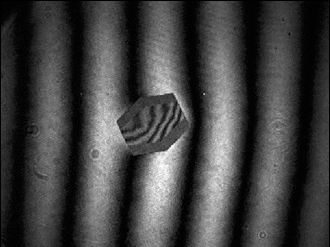Daniel C. McCarthy, News Editor
Some things just aren't made for this earthly existence. Scientists at the University of California at Irvine hope to prove that growth of macromolecular protein crystals and large biological molecules from solution improves in the absence of gravity with experiments on a shuttle flight and eventually on the international space station. Research into how these structures grow makes them valuable as an intermediary to other research such as x-ray diffraction analysis.
 Interferometric measurements of a growing lysozyme crystal show phase differences corresponding to protein depletions in the surrounding solution. Scientists hope to repeat the experiment in space to witness an expanded and more structured process behind crystal growth. Courtesy of Teledyne
Brown Engineering Inc.
Interferometric measurements of a growing lysozyme crystal show phase differences corresponding to protein depletions in the surrounding solution. Scientists hope to repeat the experiment in space to witness an expanded and more structured process behind crystal growth. Courtesy of Teledyne
Brown Engineering Inc.
Teledyne's interferometer in this application echoes the function of a liquid crystal variable retarder developed by Meadowlark Optics of Frederick, Colo. But where Meadowlark's device examined the surface of the protein crystal, Teledyne's instrument measures concentrations in the surrounding fluid.
The solution's index of refraction undergoes a change as protein molecules cluster faster than the rate of diffusion. The instrument developed by Teledyne and manufactured by Coastal Optical Systems Inc. is accurate enough to measure a 1.5 x 10-5 change in the refractive index of the solution. The interferometer's spatial resolution is finer than the 0.02-mm-pixel resolution of the 5 x 5-mm charge-coupled device (CCD).
"These concentrations are sensitive to convection from gravity, so we can't get accurate observations of how they influence crystal growth in a gravity environment," said Alexander McPherson, a professor of molecular biology and biotechnology at the university and leader of the research.
But while spaceflight offers a friendlier environment for delicate growth processes, it can wreak havoc on interferometric devices. "The environment is critical when talking about interferometers," said Jeff Howard, a Teledyne engineer. "Many efforts have been made to use interferometers in zero-gravity experiments, but none had a device this small or this rugged. This instrument performs like a tabletop lab experiment but is not susceptible to the vibration and shock of spaceflight."
Teledyne's earlier breadboard versions minimized image jitter. Later, the company concentrated on making the device smaller while preserving this stability. It did this by using solid, fused-silica optics in the instrument's head, a phase-shifting Mach-Zehnder interferometer. All told, there are 26 optical elements including a fiber collimator, Fourier transform optics, a phase modulator and a CCD. Coastal Optics glued the interferometer together with the other components to create a rugged device that is compact enough to fit in the palm of a hand.
